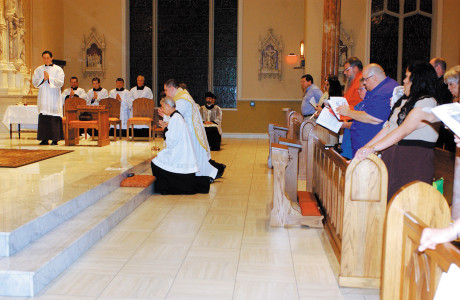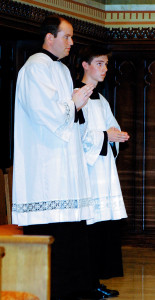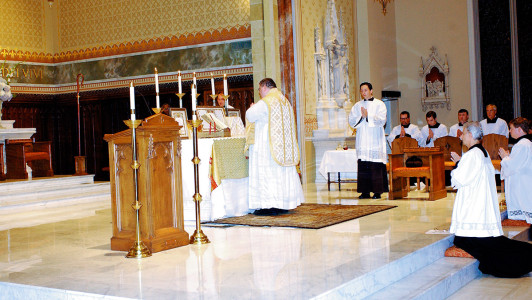By Mary Woodward
& Maureen Smith
JACKSON – On Friday, Sept. 5, 100 people gathered in St. Peter Cathedral to celebrate Mass in the extraordinary form of the Roman Rite, known by many as the Tridentine Mass or the Latin Mass. Father Scott Haynes, SJC, from Chicago was the celebrant for the mass which was the votive Mass of the Sacred Heart of Jesus.
Father Haynes, a native of Starkville, along with Tuscaloosa native, Father Anthony Rice, SJC, spent several days prior to the Mass offering training for clergy who would like to learn to celebrate the extraordinary form. The two priests also assisted in training boys and men interested in being altar servers for the extraordinary form.

The Mass celebrant and servers genuflect during the procession. Father Scott Thomas is visible in the background sitting in choir, meaning he wore liturgical vestments, but did not concelebrate the Mass.
Fathers Haynes and Rice are members of the Canons Regular of St. John Cantius, a religious order of priests devoted to the extraordinary form and preserving the tradition of Latin, chant and polyphony in the church. They also do workshops for the ordinary form of the Roman Rite.
As a simple explanation, in 2007, then Pope Benedict issued a document entitled “Summorum Pontificum” which gave priests anywhere around the world permission to celebrate the Mass using the 1962 Missal – meaning the Tridentine mass (from the Council of Trent).
In his letter to bishops concerning the document, he explained that the liturgical tradition of the Roman Rite incorporated two forms – the ordinary, which we celebrate regularly, and the extraordinary, which many have continued to have a devotion to. Both forms make up the Roman Rite and are to be seen as the continual flow of the 2000 year liturgical tradition of the church. He emphasized there was no fracture of the tradition at the Second Vatican Council.
Both forms of the Mass use the same words of consecration, therefore it is the same Eucharist. Both forms are based in the Latin language and may be celebrated in Latin. Both forms have ancient roots in the church’s liturgical tradition.

Robert Rutherford (left) and St. Joseph School senior, Patrick Morgan, served at the Mass after training for a week.
Working from this understanding, UnaVoce Mississippi, with the permission of Bishop Joseph Kopacz, invited Fathers Haynes and Rice to come to the diocese and put on the workshop which concluded with the Sept. 5, Missa Cantata or Sung Mass.
UnaVoce is a lay Catholic organization dedicated to Gregorian chant and polyphony in the church and the incorporation of it in both forms of the Roman Rite. Members of UnaVoce provided the servers and schola (choir) for the Mass Sept. 5.
Father Haynes, explained some of the differences between the extraordinary form and the ordinary form. “The priest is facing East, toward the altar, known as ad orientem or toward the Orient. This is scriptural. We read that in the end time, Christ comes from the East. The point is not that he’s turning his back on the people or that he’s shy, he is together, with the people, in joyful expectation looking forward to the end times – to the coming of Christ. Also, he is looking to the crucifix, a central part of the Mass,” said Father Haynes.
One difference noticed by some was there were no concelebrants to the Mass. Priests who were present sat in choir – meaning they vested in the liturgical attire of cassock, surplice and biretta and sat off to the side.

Father Scott Haynes, SJC, celebrates the votive Mass of the Sacred Heart of Jesus Friday, Sept. 5 in the cathedral using the extraordinary form. The prayers and songs were in Latin and Father Haynes faced ‘ad orientem,’ or toward the altar. (Photos by Maureen Smith)
Father Joe Dyer, pastor in Forest, Newton and Paulding, came to the Mass and sat in choir along with Father Matthew Simmons, director of vocations for the diocese; Father Scott Thomas, pastor in Clarksdale; and Father Rice. Fathers Simmons and Thomas participated in the training. Father Rice preached the sermon for the Mass.
“When I went into the seminary the Mass was still in Latin,” said Father Dyer. “What is important to me is the music. The rich history of polyphony is worth keeping. I thought the music was just beautiful and I thought the choir did a great job with the music,” he added.
Plans now are for some simple diocesan directives for the extraordinary form to be issued by Bishop Kopacz. There are also plans in the near future to celebrate the ordinary form in Latin at the Cathedral.
